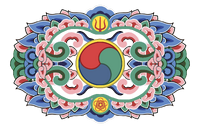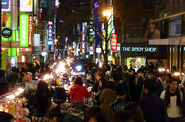| Country | Dankuk |
| Region | Hyonggi |
| Government | Mayor-Council |
| Governing body | Seongtaek City Rowi |
| Mayor | Pablo Alfonso Yi |
| Ruling party(s) | Communist Refoundation Party |
| Area | 821 km² |
| Population | 2,654,200 |
Seongtaek (Kyomal: 晟宅, Resplendent House, Draniano: Seongtaek, Draddwyr: 亻口丿士栄彳巳/Soingtec), officially the Seongtaek Metropolitan City, is a coastal metropolis in Dankuk. The city is the busiest port in the nation and the nation's second largest city by population and GDP; receiving the majority of the nation's shipping and freight.
Economically, Seongtaek is a highly important port for Dankuk. Because the city is strategically located in the near-middle of the country, it is the nation's primary point of common trade and travel. The city retains a rivalry with Gongmangdo.
Seongtaek is a cultural melting pot, with significant contributions from all three ethnicities of Dankuk. This can be seen in Seongtaek's architecture and physical form, whose old forms envoke both the Gobae and Egelian colonial periods.
History
Seongtaek is near the ruins of both the heroic city of Taegang and the classical city of Kukhol. Kukhol in particular was the center of arts and sophistication on the peninsula for the vast majority of the classical period, maintaining lucrative naval trade with contemporary Indrala, Gao-Soto, and Sekowo. After the fall of Kukhol, the city was razed and all high culture was virutally wiped out. Later, the region stabilized, but declined. By the 15th century the region was known as Soseoshi (小西市) and had been reduced to a minor fishing village
The city truly began in it's modern form when Egelian settlers established the colonial city of Santa Sharika in 1898 during the decline of Gobae. Santa Sharika's strategic location and proximity to the colonial capital of Iglesia Major and Egelion itself made it prime real estate. The city grew exponentially over the years, serving as a crucial port for the Selucian Empire in northern Dovani. After the Great Kyo Revolution of 3608 the city was renamed to Seongtaek in recognition of the original inhabitants of the area.
Historic Santa Sharika still exists as a major district within Seongtaek, but has been damaged over time by wear, neglect, and urban development. Nonetheless, it remains a popular tourist spot due to its unique Egelian architecture and old-fashioned urban design.
Geography
Seongtaek is located in the southwest region of Hyonggi Province along the coast of the West Sea. Much of Seongtaek is flat and heavily urbanized but further inland can be more hilly with denser patches of forestation.
Seongtaek has one of the more favorable climates on the Dranian Peninsula as a result of warmer winds that come off the Ocean from the south. The warmer months can be quite rainy, particularly during monsoon season in mid-August to late-September. The winters can still be very cold; snow is common but the water remains sufficiently warm enough for year-long, uninterrupted transit. The last recorded freezing of Santa Sharika Harbor, the city's economic heart, was in the year 4713, even then being an anomaly.
Cityspace
Seongtaek has been at the center of much of Dankuk's modern economic development alongside historical rival, Gongmangdo. Both cities are considered the main drivers of Dankukian industry; Seongtaek serving as the nation's foremost trade ang shipping hub. Older districts of Seongtaek boast the dynamic Draniano architecture that defined the colonial foundations of Santa Sharika, whereas the sprawling newer districts are highly modern and scattered with numerous skyscrapers. The ruins of Kukhol dot the very edges of the outer city, but most traditional Kyo architecture is small-scale.
Economy
Due to its beneficial coastal location and status as Dankuk's main port, Seongtaek is the economic capital of the nation's center and west coast. Whilst the fascist rule of the DNWA deeply harmed Seongtaek's economic development, the city has since become the center of Dankukian freight and export.
Transportation
A commuter rail service, the Seongtaek Metro, services much of the city and reaches most of its districts. This rail service is interconnected with the national Danrail high-speed railway, which has an office in Seongtaek. The Port of Seongtaek is the primary container and passenger port in Dankuk. Much of the nation's international shipping goes through this port.
Government and politics
Seongtaek Metropolitan City is defined by two areas; Seongtaek Proper (officially the "Seongtaek Metropolitan City Inner Area"), and Outer Seongtaek (Seongtaek Metropolitan City Outer Area"). Both areas form to make up the wider political boundaries of the City. Whilst Seongtaek Metropolitan City is always translated into Luthorian as "City"; its administrative name actually means "Seongtaek Metropolitan Area" in Kyo,
Seongtaek elects a Mayor every three years, and maintains a City Council. Seongtaek has historically supported economically liberal and libertarian political parties during the times of the Dranish Republic, but beginning with the Kyo Revolution the city has seen a leftist shift, Today Seongtaek is noted by political commentators as a "hard red" city; being very supportive of the left wing policies of the Communist Refoundation Party and the Socialist Worker's Party. Seongtaek's current mayor is Communist, and the City Council is dominated by a threeway left wing alliance.
Administrative Divisions
Seongtaek is divided into two areas, Inner Seongtaek and Outer Seongtaek. Because the city has the political powers mostly equal to a Province, inner Seongtaek is much larger than inner Seongtaek, but with a smaller population.
Demographics
Seongtaek is a very diverse city due to its position as a local and international trade hub. According to the government's 5315 census; Seongtaek's primary ethnic group is Kyo (53%), followed closely by Draniano (31%). Ethnic Sekowans account for 6% of the population, followed by Draddwyr people (4%), Indralans (3%), and Kunihito (1%). Seongtaek may one day develop a Yeudish population as well, given the development of close Dankuk-Beiteynu trade relations, which has in turn spurred small scale Beiteynuese immigration to the city.
International Relations
Sister Cities
Gallery

|
大拜花國 Kingdom of Great Bae | |
| Geography • History • Culture • Economy • Government | ||
|---|---|---|
| History | Baekgu Dynasty • Beonyeongsalm Palace • Dranland • Dranian Zenshō Revolution • Egelian Drania • Flag of Dankuk • Great Kyo Revolution • House of Ryeo • House of Santiago • Kyobando Manifesto • Kyo-Indralan Revolutionary War • August Revolution • Dranian Civil War • DNWA • Republican Period • Baek Restoration • Timeline of the History of Dankuk | |
| Subdivisions | Provinces: Metropolitan Cities: | |
| Politics | President of Dankuk • Chairman of the Council of Ministers • National Congress • Constitution of Dankuk Political Parties | |
| Demographics | Religion: Aurorian Patriarchal Church • Daenism • Seodongyo • Sindo • Zenshō Ethnicity: Majority: Kyo Minority: Draddwyr • Draniano | |







